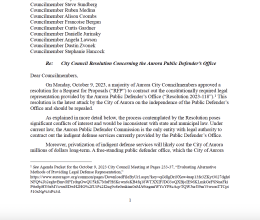Frequently Asked Questions
Q: Why did Sam Mandez go to prison?
A: Sam Mandez was arrested in 1996 for a crime that occurred in 1992, when an elderly woman was murdered inside her home during a burglary. Jurors interviewed after Sam’s conviction stated that they believed Sam broke a window at some point in time that ultimately allowed entry into the woman’s home, but that Sam did not participate in any injury to the woman. Sam was convicted of Felony Murder, which is classified as First-Degree Murder in Colorado. Sam and his counsel continue to maintain his innocence.
Q: If members of the jury thought he did not physically harm the victim, why was he convicted of murder?
A: Simply put, the law states that a felony murder occurs whenever someone dies during the commission of any felony, such as burglary. Burglary means that someone entered a home unlawfully to commit any crime inside. Consequently, Sam’s counsel believe the jury felt compelled to convict Sam of felony murder because they had no other option under the law given their conclusion that Sam at some point had broken a window which allowed others entry into the woman’s home.
Q: How old was Sam at the time of the crime?
A: Sam was fourteen years old at the time of the crime, but he was not arrested until he was eighteen.
Q: Why was Sam sentenced to life without parole as a juvenile?
A: Under Colorado law in 1997, once Sam was convicted of felony murder, the judge had no choice but to sentence him to life without parole. Under the law at the time, the sentencing judge could not consider any mitigating information about Sam, such as his youth, the circumstances of his life, and particularly how the evidence did not suggest he injured anyone.
Q: Is life without parole for juveniles constitutional?
A: Recent decisions by the United States Supreme Court have placed constitutional limits on sentencing juveniles to life without parole. The Court declared that when a juvenile commits a crime, it violates the Constitution to sentence that juvenile to life without parole if the juvenile did not kill anyone and did not intend to kill any one. Also, prior to sentencing a juvenile to life without parole, the court must first consider mitigating evidence, including the fact of the juvenile’s youth. In concluding that there are constitutional limits on sentencing juveniles to life without parole, the Court relied on scientific evidence differentiating youth from adults. The Court held that youth always remain less culpable than adults, no matter how heinous the crime; that youth always serves as a mitigating factor, and that young people have a heightened capacity for change. The Court also recognized the natural immaturity and recklessness of young people, and that they cannot foresee the consequences of their actions and engage in risky behaviors with peers.
Q: Have Sam’s attorneys appealed the original sentence?
A: Sam’s counsel have challenged Sam’s sentence in the Colorado courts. They believe Sam’s life without parole sentence constitutes cruel and unusual punishment in violation of the 8th Amendment of the United States Constitution, and that Sam fits into the category of juveniles unconstitutionally sentenced to life without parole because he did not kill the elderly woman, nor did he intend to.
Moreover, Sam’s attorneys believe the mandatory life without parole sentence for Sam was unconstitutional, because the sentencing court was prohibited from hearing or considering any mitigation in his case, including the fact that Sam was a fourteen years old at the time of the crime.
Q: Why was Sam placed in solitary confinement?
A: Sam was placed in administrative segregation (long-term solitary confinement) in 1998 for non-violent, minor prison rule infractions -- participating in a three-way phone call and tampering with a bathroom lock.
Q: Is Sam living in solitary confinement today?
A: Yes, Sam is living in solitary confinement today. In late 2012, Sam was moved out of administrative segregation and into the Colorado Department of Correction’s new Residential Treatment Program (RTP), which purports to provide intensive mental health care to those prisoners with the most significant mental health needs in a setting that avoids the isolating conditions of administrative segregation. Unfortunately, early reports on the RTP show that some seriously mentally ill prisoners – like Sam – are stuck in the lowest levels of the program in a form of isolation almost identical to administrative segregation. For all but one month in the last eleven months in RTP, Sam has spent in excess of 22 hours per day alone in his cell, has taken his meals alone in his cell, has been permitted to leave his cell only in full restraints, and has been denied meaningful human contact. Intensive mental health treatment cannot be provided in solitary confinement, as is evidenced by Sam’s out of cell therapeutic time during his first six months in the program. During that time, Sam received an average of twelve minutes of individual therapy each week and, over a ten week period, received no out-of-cell therapy at all. As Sam’s expert, Dr. Jeffrey Metzner, explained in the film, for Sam to get better, he must get out of solitary confinement and into intensive mental health treatment.
